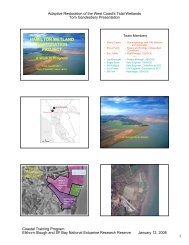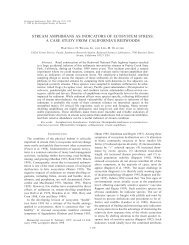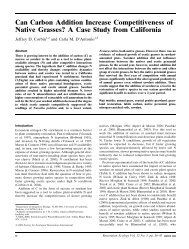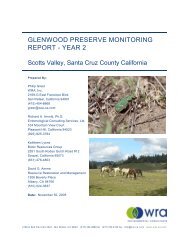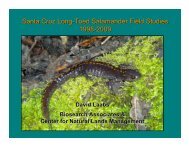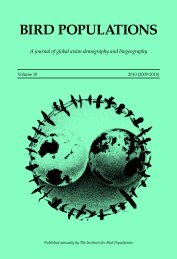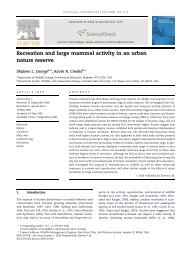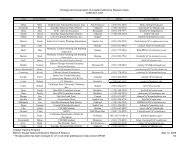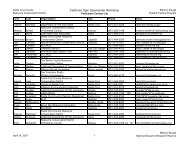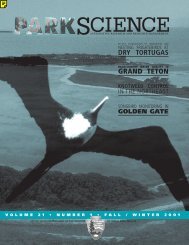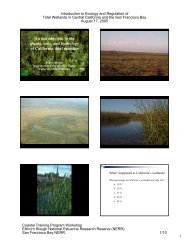California Tiger Salamander Bibliography - the Elkhorn Slough ...
California Tiger Salamander Bibliography - the Elkhorn Slough ...
California Tiger Salamander Bibliography - the Elkhorn Slough ...
You also want an ePaper? Increase the reach of your titles
YUMPU automatically turns print PDFs into web optimized ePapers that Google loves.
Austin, C.C. and H.B. Shaffer 1992. Short, medium, and long-term repeatability of<br />
locomotor performance in <strong>the</strong> tiger salamander, Ambystoma californiense. Functional<br />
Ecology 6(2):145-153.<br />
Cook, D.G., P.C. Trenham and P.T. Nor<strong>the</strong>n. 2006. Demography and breeding<br />
phenology of <strong>the</strong> <strong>California</strong> tiger salamander Ambystoma californiense) in an urban<br />
landscape. Northwestern Naturalist 87:215-224.<br />
Drift fence study of breeding migrations at a large vernal pool in an urbanizing area of<br />
Santa Rosa, Sonoma County. Adults were captured as <strong>the</strong>y arrived at <strong>the</strong> breeding pond<br />
in 1999, 2002 and 2003. Total numbers of adults estimated to be breeding at this pond<br />
ranged from 65 to 107. Whereas some males arrived at <strong>the</strong> ponds following <strong>the</strong> first rains,<br />
females only arrived in substantial numbers after <strong>the</strong> pond filled. Yearly breeding<br />
migrations began anywhere from November to January, depending on rainfall.<br />
Barry, S.J., and H.B. Shaffer. 1994. The status of <strong>the</strong> <strong>California</strong> tiger salamander<br />
(Ambystoma californiense) at Lagunita: a 50-year update. J. of Herpetology 28:159-164.<br />
Summary of <strong>the</strong> ecology, natural history and history of <strong>the</strong> CTS population on Stanford’s<br />
campus. Established strategy still used for managing <strong>the</strong> draw-down of Lagunita to<br />
minimize larval CTS mortality.<br />
Davidson, C., H.B. Shaffer, and M.R. Jennings. 2002. Spatial tests of <strong>the</strong> pesticide<br />
drift, habitat destruction, UV-B, and climate-change hypo<strong>the</strong>ses for <strong>California</strong> amphibian<br />
declines. Conservation Biology 16:1588-1601.<br />
Whereas upwind pesticide use is strongly correlated with <strong>the</strong> disappearance of four of<br />
<strong>California</strong>’s ranid frogs, no similar correlation was observed for CTS disappearance sites.<br />
For CTS <strong>the</strong> most significant difference between extant and extirpated sites was that<br />
extant sites had significantly less urbanized land within 5km.<br />
Fisher, R.N. and H.B. Shaffer. 1996. The decline of amphibians in <strong>California</strong>'s Great<br />
Central Valley Conservation Biology, 10:1387-1397.<br />
Documented rarity of native amphibians in <strong>the</strong> low elevation portions of <strong>the</strong> central<br />
valley. Attributed decline to habitat loss and disturbance in <strong>the</strong> agricultural central valley<br />
and also introduced predators. First peer reviewed study of general decline in <strong>California</strong>.<br />
Fitzpatrick B.M., J.R. Johnson, D.K. Kump, J.J. Smith, S.R. Voss, and H.B. Shaffer.<br />
2010. Rapid spread of invasive genes into a threatened native species. Proceedings of <strong>the</strong><br />
National Academy of Sciences of <strong>the</strong> United States of America 107:3606-3610.<br />
Genetic assessments of samples along a transect from Salinas to Alameda County<br />
indicate that in general genes from <strong>the</strong> introduced tiger salamanders have not spread far<br />
beyond <strong>the</strong> sites of original introduction. However, three genes show a very different<br />
pattern with rapid spread far beyond <strong>the</strong> apparent sites of introduction, indicating that<br />
natural selection is favoring <strong>the</strong> spread of <strong>the</strong>se markers. This complicates <strong>the</strong> assessment<br />
of hybrid versus native status. An example from Fort Ord show that only one population<br />
has a large fraction of introduced genes for markers o<strong>the</strong>r than <strong>the</strong>se exceptional markers




